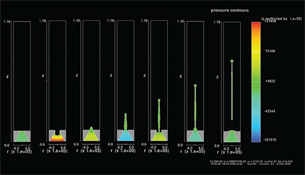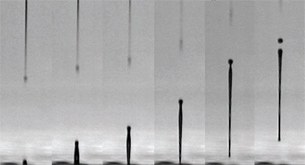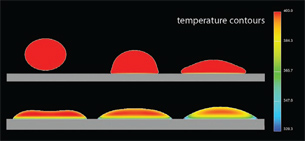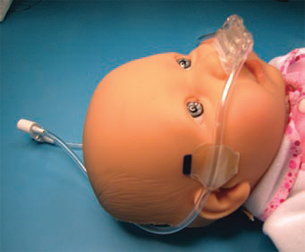November 1, 2008
By Pamela J. Waterman
  These images show simulated and measured ink-drop formation in an Océ Technologies inkjetprinthead. Flow3D software simulated the effects of a drop’s tail formation for various designs.The tail can break up and adversely affect print quality. (Images courtesy of Flow Science) |
In Part 1 of this series DE asked several users of computational fluid dynamics (CFD) software about their product challenges and solutions. Their common need was to create better designs in less time; their different approaches reflected how various CFD packages now play a role in the earliest stages of product design.
In Part 2 we spotlight three more examples of first-pass CFD, examining why it was particularly effective, how it fit into the general design process, and where there’s room for improvement.
Color Flow Over the Years
Predicting flow characteristics drop by drop is a major concern of designers at Océ Technologies BV. Headquartered in the Netherlands, this company started out in 1877 creating edible yellow food-coloring to give pale winter margarine the hue of summer butter. The founder’s inventor-grandson turned his attention to ammonia-free copying of technical drawings (“ohne componente” or “without components” became O.C.) and thus transitioned the company to compete in the emerging reprographics industry. Now Océ applies ink to paper, meeting the challenging demands of monochrome and color printing in the digital world. The company uses CFD software to check critical processes and identify new concepts for inkjet printhead development.
Herman Wijshoff, an analytical R&D engineer in the computational physics group at Océ, says he and other staff have used Flow3D from Flow Science since 1999 to investigate various characteristics of drop formation, particularly to guide them when evaluating new technologies.
“The simulations add value ]because] they clarify the impact of critical design parameters such as nozzle dimensions, ink properties and the shape of driving waveforms,” says Wijshoff. This is no small feat, given that the volume of the drops in modern imaging technology ranges from 32 picoliters to just 2 picoliters. He adds, “With Flow3D simulations we design a new concept before starting the time- and money-consuming manufacturing of a new printhead.”
The accurate free-surface capabilities of Flow3D were very attractive to the Océ engineers; previously, they had had to simulate drop formations with a finite element analysis (FEA) code that required a great deal of remeshing in the process. Wijshoff notes that Flow3D is also easy to use and runs on local Windows-based platforms. He was up and running on the software after just a three-day training session, and is very pleased with the ongoing support.
Better Breathing with CFD
Who wouldn’t appreciate the following scenario of engineering success: learn new software on day 1, try various real designs on day 2, and save $250K in prototypes on day 3. That was the case for Steve Han at VIASYS Healthcare, now part of Cardinal Health, when tasked with using CD-adapco’s STAR-Works to improve one of his company’s main products.
 This image describes the temperature change of Océ printer ink droplets over time as dropletscool. The simulation was completed with Flow3D software. (Image courtesy of Flow Science) |
Han and his colleagues needed to change the design of a continuous positive airway pressure (CPAP) ventilator device for treating apnea in infants. The condition is a critical problem where a newborn stops breathing involuntarily. The treatment involves delivering a constant stream of compressed air through a facemask. However, maintaining the correct pressure for each patient is the challenge. Moreover, the compressed-air generators can be expensive and therefore difficult for some hospitals to purchase.
VIASYS wanted a regulator that could control the necessary range of pressures while operating with more affordable generator systems. Unfortunately, the geometry of the component is extremely complicated, so designing, building, and testing physical prototypes generally took a year of work for each, while costing hundreds of thousands of dollars per project.
This time, Han, without prior CFD experience, produced multiple air-flow design changes after a single day of training. Since STAR-Works is embedded in the SolidWorks software suite, he could easily access the menus through the familiar SolidWorks GUI. By the third day, he had modified the CAD model such that the regulator would work with a remarkable 48 percent less pressure, a fact that opened up its use to multiple ventilator products and smaller, less expensive generators.
Han and his team found the software especially fast to use because STARWorks CFD results are fully associative with the CAD geometry and stored as part of the model. After each modification to the design, a simple click updated the simulation results almost instantly. The results: three days, multiple designs, and a year of work saved (See image above).
 A continuous positive airway pressure (CPAP) flow device, successfully redesigned with D-adapco’s STAR -Works, operates on a ower pressure than previous products. The new design allows use of less-expensive regulator pump systems and wider use of the medicaltreatment. |
Focus on Accuracy
For senior mechanical engineer Sarah Luo at Aurora Optical in Tucson, Arizona, flow problems arise not in the use of a final product but in its manufacture. Aurora Optical designs and produces very small, high-precision cameras for cell phones, laptop computers, and security systems. Its product line includes camera modules less than 5mm across housing 3mm lenses, and most projects are custom orders.
Luo’s job entails simulating the injection-molding process for creating plastic camera parts with dimensional tolerances of 10 microns. Allowing for shrinkage during molding is a critical issue for producing parts with such accuracy, so Luo uses ANSYS/CFX for thermal analysis and optimization studies on the 3D CAD model of the mold.
“We simulate how the flow will fill the cavity,” says Luo, “then we study the pressure, temperature, and process parameters. We assume iso-properties for the material, see how long it will take to fill the cavity, and ]ask] what kind of packing pressure will it take?” Luo then exports the non-uniform temperature distribution and pressure results from CFX into ANSYS’ Workbench software to study the cooling cycle and all the different phases the plastic undergoes. Finally she is able to make recommendations about the process parameters to guide manufacturing staff in controlling part shrinkage, explaining, “We can optimize the process to get quality parts, and this can reduce production cycle time.”
Aurora Optical had owned Workbench for some time, then added CFX capabilities a year ago. ANSYS sent Phoenix Analysis & Design Technologies, a local consulting company, to give Luo two days of mentor-type in-house training, then she was able to start her own analyses. She says CFX is particularly effective for her needs because when you set up the operating conditions, the software gives you multiple choices and warns you if your selection is inappropriate for the particular thermal approach you want to take.
Luo also likes CFX’s postprocessing animation tools, as well as the fact that once you’ve set up a simulation, the software lets you save the materials, conditions, and physics and reuse them on a new problem. By building on similar projects and just having to change a few values, Luo saves a great deal of analysis time.
What Could Be Better?
In engineering, there’s always room for improvement, and the realm of upfront CFD software is no exception. DE asked some of the users about their wish lists.
Oshkosh Truck’s Pennau (see DE Sept. 2008) says he’d like to see capabilities in CFDesign for multi-phase and mixed fluids (i.e., water and air) analysis. Luo at Aurora Optical would like to see user functions enhanced in ANSYS/CFX so that when she creates a multi-variable analysis, she can type the values in directly, instead of creating an intermediary chart of values.
Océ’s Wisjhoff sees potential in having Flow3D offer more interaction models that couple solids with the surrounding air. And CD-adapco users will appreciate new releases of the STAR product line that handle problems with increased physics complexity.
For all these cases, it is clear that applying CFD analysis early and often in the design process is saving time, cutting costs, and leading to valuable innovations that might otherwise have been missed.
More Info:
ANSYS, Inc.
Canonsburg, PA
CD-adapco
Plymouth, MI
Flow Science Inc.
Santa Fe, NM
SolidWorks Corp.
Concord, MA
Contributing Editor Pamela J. Waterman is an electrical engineer and freelance technical writer based in Arizona. You can contact her about this article via e-mail sent to [email protected].
Subscribe to our FREE magazine, FREE email newsletters or both!
About the Author
Pamela Waterman worked as Digital Engineering’s contributing editor for two decades. Contact her via .(JavaScript must be enabled to view this email address).
Follow DE





